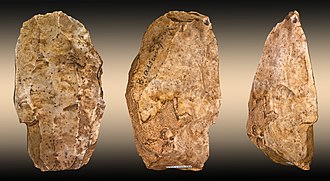Palaeolithic Moellia (Pacifica)

Palaeolithic Moellia, or Palaeolithic Rhayna, is the longest period of its prehistory. It encompasses the palaeolithic in the Moellia region from the first arrival of Homo erectus to the area 1.5 million years ago, to the end of the Last Glacial Period Peak in Moellia in 20,000 BCE, with the arrival of the first modern humans in around 30,000 BCE.
It's characterized by a cyclic change in the climate of the region due to the variation between ice ages and interglacial periods, and the developments in the lithic industry with the arrival of different species of humans to the zone.
Multiple archaeologic sites sprawl about the entire region, tracing a history of the life and expansion of different humans throughout the fertile lands of Lake Kryo and the rivers of the region. Of notable importance is Mt. Atzali in Rhayna, with fossils spanning the entire period.
| History of Rhayna (Pacifica) |
|---|
 |
|
|
Lower Palaeolithic
The lower Palaeolithic (c. 1.5 Ma — 115 ka BCE) is the longest section of the Palaeolithic, starting with the first arrival of Homo erectus to Moellia, and ending with the start of the Last Glacial Period, which early signs could have been the depopulation of Homo erectus around 119,000 BCE.
The early half of the period starts with the arrival of the first humans and ends with the depopulation of Homo heidelbergensis. It's characterized by a warm climate similar to the climate of the region nowadays, and primitive tools. Meanwhile, the late half of the lower Palaeolithic ends with the start of the Last Glacial Period, where all fossil found are exclusively from Homo erectus. Here, the temperatures start going down and the difference between night and day temperatures smoothen out. The mediterranean climate of Lake Kryo extends beyond its basin, while the semi-arid and arid climates of Nea-gy and Alla-gy respectively become more temperate, and the primitive, crudely sharpened stones evolve into more elaborate bifaces.
Moellia was populated exclusively by Homo erectus and Homo heidelbergensis in this period, which are the responsible for all the lithic industry from this period found in the region.
Middle Palaeolithic
The middle Palaeolithic (c. 115 ka — 30 ka BCE) ends with the first arrival of Homo sapiens to the zone. The entire period is abnormally devoid of human remains, except for some sparse fragments in a cave found mid-way of the Apoala River in Alla-gy. These remains are theorized to be from an individual of a subspecies of Homo heidelbergensis, however, more remains are to be found for a complete picture of this theorized subspecies and their presence in the region.
Besides this single case, no other remains of humans are found in the entire region from this period until 30,000 BCE, leaving a void in Moellia's human history.
Upper Palaeolithic

The upper Palaeolithic (c. 30 ka — 20 ka BCE) starts with the arrival of Homo sapiens in the north of Rhayna, who quickly expands unopposed through the entire region, and ends in 20,000 BCE with the end of the Last Glacial Period Peak, with moderns humans having fully settled in the entirety of Moellia in 15,000 BCE.
The early half of the upper Palaeolithic ends with the start of the Last Glacial Period Peak around 26,000 BCE. The late half of the period sees the lowest temperatures recorded in Moellia, which provides the humans in the region with a higher quantity of food.
The end of the Last Glacial Period Peak, the rising temperatures and increasing frequency of droughts forces humans to adapt and migrate from the zones which soon would be engulfed by the growing deserts, displacing a high population to the river beds and the Lake Kryo basin.
References
- "Acheulean Tools of Central Cordilia." Journal of Archaeology, vol. 45, no. 3, 2020, pp. 203-217.
- Smith, J. "Homo sapiens Settlement Patterns in Palaeolithic Moellia." Paleoanthropology Today, 2021.
- Walker, P., et al. "Climatic Change and Human Adaptation in Late Pleistocene Moellia." Cordilian Archaeological Review, vol. 12, no. 2, 2019.
- "The Apamea Cave Complex: Insights into Early Social Structures." Rhaynan Journal of Prehistory, 2022.